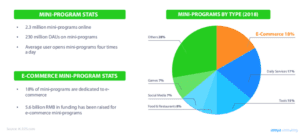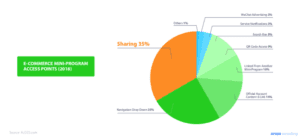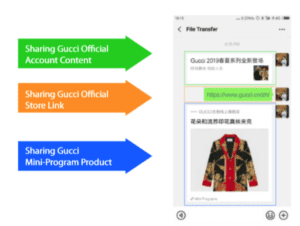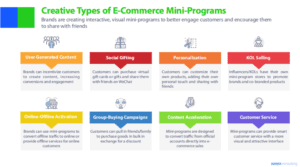Why China ecommerce is going crazy for WeChat mini‑programs
China’s more than 1 billion WeChat users can make purchases through mini-programs without leaving WeChat. 18% of mini-programs are devoted to ecommerce, yet foreign brands have been slow to take advantage of this golden selling opportunity.
by Internet Retailer
This article originally appeared on Internet Retailer
China’s more than 1 billion WeChat users can make purchases through mini-programs without leaving WeChat. 18% of mini-programs are devoted to ecommerce, yet foreign brands have been slow to take advantage of this golden selling opportunity.

Franklin Chu, managing director, Azoya International
WeChat mini-programs have been taking China’s ecommerce industry by storm.
WeChat is the most popular social commerce platform in China, boasting more than one billion users. Built on top of WeChat’s existing platform and IT infrastructure, mini-programs are mini-apps that customers can seamlessly access and use without leaving the WeChat app. Users are using mini-programs in lieu of mobile apps to book movie tickets, order food delivery, and more, making it an increasingly important channel for retailers to engage customers.
However, the complexities of China’s internet ecosystem make it difficult for U.S. retail players to understand WeChat and how WeChat mini-programs work. Despite having been around for two years, only a handful of top global brands have begun to sell to China with WeChat mini-programs.
Brands can design their user interfaces the way they want to and have control over customer data.
To help foreign retail companies understand WeChat mini-programs, Azoya Consulting recently published the report, “The WeChat Mini-Program Playbook for Ecommerce.”The report showcases how leading brands such as YSL, Dior, and Sephora are using WeChat mini-programs to sell directly to Chinese consumers.
WeChat Mini-Programs for Ecommerce
Online shopping is a major focus for mini-programs. Of the 2.3 million mini-programs on the market, 18% are dedicated to ecommerce, making online shopping the most commonly used application in 2018, according to data provider ALDZS.

A Brief Overview of WeChat Mini-Programs
WeChat stores benefit from WeChat’s user base of over one billion registered users, and users can use integrated WeChat Pay to complete ecommerce transactions.
Group-buying platform Pinduoduo, which grew its user base to over 300 million within three years on the back of its wildly successful mini-program, is one example. Pinduoduo went public on the NASDAQ stock exchange last summer and is raising another billion dollarsto compete with Alibaba and JD.com.
Why Consumers Choose Mini-Programs for Ecommerce
Ease of accessibility and social sharing features have been key to the success of ecommerce mini-programs.
First of all, mini-programs are limited to two megabytes of data per page, making it conducive for users to quickly load and share them with other users. In fact, 35% of users access them because they’re shared by friends or family.

How Consumers Access Ecommerce Mini-Programs
In total, there are over 60 different ways in which users can access ecommerce mini-programs. Mini programs are embedded almost everywhere in the WeChat user interface, making them easy to find and use.
Secondly, users can complete closed-loop transactions where they can discover, browse, and pay for items all without downloading an app or loading a page on a separate browser. Users can get everything done without leaving the WeChat ecosystem.
This integration is possible because all mini-programs come equipped with WeChat Pay, which users can use to complete mobile ecommerce transactions with just a few taps of the finger. The convenience of WeChat and its all-inclusive ecosystem is partly why Chinese internet users spend a third of their online time in WeChat on a given day.
Why Brands are Using Mini-Programs for Ecommerce
For brands, WeChat mini-programs provide all of the freedom and independence of a brand website, plus access to WeChat’s diverse ecosystem and massive user base.
Brands can design their user interface the way they want to—with flashy pictures, videos, GIFs, etc. —and also access and analyze customer data as they please. Online marketplace platforms, such as China’s Tmall and JD, on the other hand, own the customer data and may limit access for brands.
Secondly, the social nature of WeChat and mini-programs means that Chinese consumers are more likely to share ecommerce promotions and items with friends and family. Such items are more visual and appealing when shared within a mini-program, rather than a simple link.

Sharing a Mini-Program vs. Official Account Content and HTML Links
Organic sharing reduces new customer acquisition costs, as brands don’t have to spend as much on ads to reach new customers.
Pinduoduo used group-buying promotions to encourage sharing among customers, which lowered its average customer acquisition costs to just 11 RMB/person($1.64/person) in 2017, compared to 225 RMB/person for JD.com and 310 RMB/person for Alibaba.
Other brands are customizing their mini-program stores in new ways that improve the customer experience and increase brand engagement.For instance, retail companies use eight different types of ecommerce mini-programs, including personalization, social gifting, and customer service.

Eight Different Types of WeChat Ecommerce Mini-Programs
For Chinese Valentine’s Day 2018 (August 7, 2018), YSL Beauty released a personalization mini-program that allows customers to customize, buy, and send gift sets to their loved ones.
The company used WeChat Moments ads (akin to Facebook News Feed ads) to reach new customers, and users responded with enthusiasm. The ad click rate was 280% higher than the industry average, and YSL Beauty sold out its two most expensive gift sets within half a day, according to Tencent data.
UK beauty retailer Feelunique also launched a six-day group-buying campaign on its mini-program in March. Customers could purchase a set of six Caudalie skin supplements products at a 37% discount if they could pull in a friend to buy the same product at the same price.
After confirming the order, customers had to share a promotion picture with friends, through which they could scan with a QR code scanner to access the discount. Group-buying promotions like Feelunique’s lower new customer acquisition costs without spending on ads—over 90% of participants in this particular campaign were new customers.
Key Takeaways
1. Mini-programs are becoming increasingly important for ecommerce as their fluid user experience and features make it easy for users to complete mobile transactions without leaving WeChat. In 2018, 18% of mini-programs were dedicated to ecommerce.
2. Brands, retailers, and ecommerce platforms alike are using WeChat mini-program stores to assert more independence over their brand stores and lower customer acquisition costs. Brands can design their user interfaces the way they want to and have control over customer data as well. In 2017, group-buying platform Pinduoduo used its mini-program to lower customer acquisition costs per person to 11 RMB, compared to 225 RMB and 310 RMB for rivals JD.com and Alibaba, respectively.
3. Brands customize their mini-program stores to better engage consumers. YSL Beauty lets customers personalize gift sets for Valentine’s Day, while beauty retailer Feelunique incentivizes customers to pull in friends and family for group-buying promotions by providing steep discounts.
Azoya assists retailers and brands as they expand into China via ecommerce.